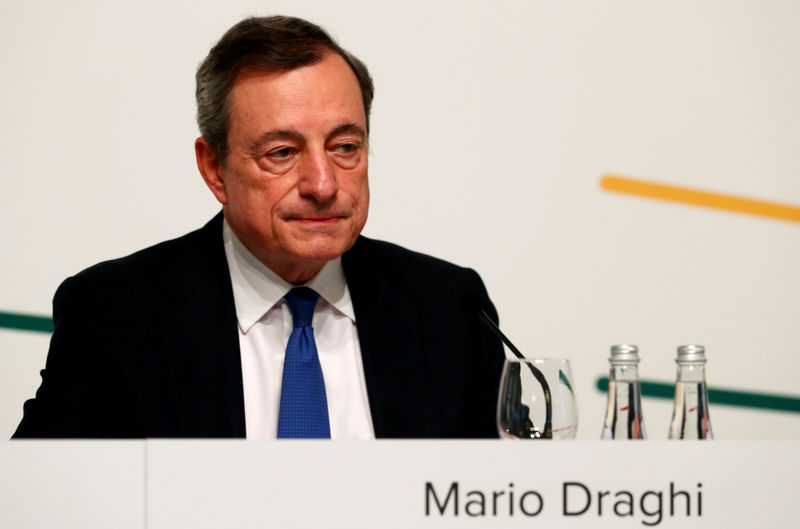By Francesco Canepa and Balazs Koranyi
SINTRA, Portugal (Reuters) - European Central Bank policymakers were divided on Tuesday, with some feeling powerless, after President Mario Draghi hinted at new stimulus measures that had yet to be discussed by the ECB's Governing Council.
Draghi told an ECB conference the central bank would ease policy again if inflation fails to accelerate, saying that fresh bond purchases, rate cuts or changes to the ECB’s policy guidance had all been “raised and discussed” at a meeting of the Council less than two weeks ago.
The message depressed the euro and bond yields, in the process angering U.S. President Donald Trump, who accused Draghi of seeking an unfair trade advantage by devaluing the euro.
But conversations with six sources on the sidelines of the ECB’s annual symposium in Sintra, Portugal, showed that rate-setters had not expected such a strong message and that there was no consensus on the path ahead.
The sources, who have direct knowledge of the situation, said the possibility of a rate cut or fresh asset buys had been mentioned last month only in passing and there had been no substantive discussion as the focus had been on a fresh package of loans.
Markets were unimpressed with Draghi's message after the June rate meeting, however.
A further escalation of the global trade war since then and a string of bad economic indicators also suggested that many of the risks were already materializing, forcing Draghi to strengthen his message, one of the sources said.
CLEAR SHIFT
Indeed, speaking on Tuesday, Draghi said more stimulus would come if there were no improvement, a marked shift from the June message that the ECB would act in the event of "adverse contingencies".
The sources said policymakers were concerned that Draghi was flagging his measures so strongly to markets as a 'fait accompli' that there would be no chance for them to disagree with them in at the next policy meeting on July 25.
But they added that, with a global trade war escalating and financial worries around Italy already high, there was little appetite for a fight in July.
Several added that very little new information will come to light before the next rate meeting, so it would be difficult to justify coming to a different policy conclusion than in June.
Nevertheless, they said the debate about which measures might be implemented, when and in what order was still wide open. An ECB spokesman declined to comment.
Some policymakers favor a resumption of the ECB’s 2.6 trillion euro bond purchase program, others prefer a simple reinforcement to the ECB’s pledge not to raise rates for a long time and some lean towards rate cuts, the sources said.
POLICY MESSAGE FIRST?
Several saw a change to the ECB’s policy message as the first port of call.
This could mean dropping a reference to when rates might rise, simply saying they would stay at present – or potentially lower – levels until specific economic conditions including a level of inflation were met, two of the sources said.
This would allow the ECB to maintain guidance for a longer period, not having to push back the timing of rate lift-off over and over again.
Others favored resuming purchases of sovereign bonds on the grounds that it would lower borrowing costs for governments, indirectly creating fiscal space for them to react to the economic downturn.
This posed some issues, however. After buying 2.6 trillion euros' worth of bonds between 2014 and 2018, the ECB is already close to owning a third of the public debt of countries such as Portugal and Germany – a threshold it has pledged not to breach so as not to constitute a blocking minority in any debt restructuring.
Draghi said the ECB would make full use of its flexibility, and some sources said this so called “issuer limit” could be disposed of or circumvented if necessary.
A handful of sources were supportive of a rate cut, although this would be made more complicated by the possible need to mitigate the side effect on banks of deeply negative rates through exemptions.
This so-called tiered system, where banks pay a reduced penalty rate on a portion of their excess reserves, has met with opposition from large parts of the Governing Council due to its complexity.
One source also pointed out that it risked creating arbitrage opportunities for some banks when taken in combination with ECB’s Longer-Term Refinancing Operation (TLTRO III), in which banks are paid to borrow from the ECB provided that they lend that cash on to households and firms.

A minority thought the ECB should refrain from acting altogether unless economic data deteriorated significantly and inflation expectations fell further away from the ECB’s target.